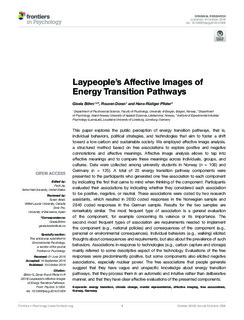Laypeople's affective images of energy transition pathways
Journal article, Peer reviewed
Published version
Permanent lenke
http://hdl.handle.net/11250/2591092Utgivelsesdato
2018Metadata
Vis full innførselSamlinger
Sammendrag
This paper explores the public perception of energy transition pathways, that is, individual behaviors, political strategies, and technologies that aim to foster a shift toward a low-carbon and sustainable society. We employed affective image analysis, a structured method based on free associations to explore positive and negative connotations and affective meanings. Affective image analysis allows to tap into affective meanings and to compare these meanings across individuals, groups, and cultures. Data were collected among university students in Norway (n = 106) and Germany (n = 125). A total of 25 energy transition pathway components were presented to the participants who generated one free association to each component by indicating the first that came to mind when thinking of the component. Participants evaluated their associations by indicating whether they considered each association to be positive, negative, or neutral. These associations were coded by two research assistants, which resulted in 2650 coded responses in the Norwegian sample and 2846 coded responses in the German sample. Results for the two samples are remarkably similar. The most frequent type of association is a general evaluation of the component, for example concerning its valence or its importance. The second most frequent types of association are requirements needed to implement the component (e.g., national policies) and consequences of the component (e.g., personal or environmental consequences). Individual behaviors (e.g., walking) elicited thoughts about consequences and requirements, but also about the prevalence of such behaviors. Associations in response to technologies (e.g., carbon capture and storage) mainly referred to some descriptive aspect of the technology. Evaluations of the free responses were predominantly positive, but some components also elicited negative associations, especially nuclear power. The free associations that people generate suggest that they have vague and unspecific knowledge about energy transition pathways, that they process them in an automatic and intuitive rather than deliberative manner, and that they have clear affective evaluations of the presented components.
